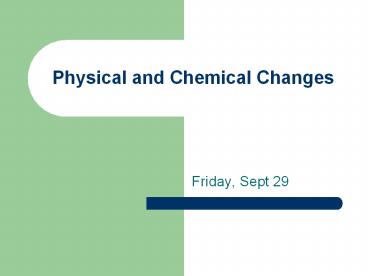Physical and Chemical Changes - PowerPoint PPT Presentation
Title:
Physical and Chemical Changes
Description:
Physical and Chemical Changes Friday, Sept 29 Physical Changes Definition: the chemical nature of the material remains unchanged. Evidence/ examples Ripping, molding ... – PowerPoint PPT presentation
Number of Views:109
Avg rating:3.0/5.0
Title: Physical and Chemical Changes
1
Physical and Chemical Changes
- Friday, Sept 29
2
Physical Changes
- Definition the chemical nature of the material
remains unchanged. - Evidence/ examples
- Ripping, molding, or reshaping the material
- Molding clay
- Phase changes
- Solid -gt Liquid -gt Gas
- Dissolution (dissolving) or recrystalization
- For example, formation of rock candy
3
Chemical Changes
- Definition The chemical identity of a substance
is altered - Evidence/Examples
- A change in the odor or color of a material
- Formation of large amounts of energy
- Heat, light or electrical
- Formation of a new form of matter with a
different boiling point or melting point - Formation of gas bubbles from a solid or liquid
- A white or colored solid appearing around the
shower head (called precipitation)
4
Lab Stations General Instructions
- Record all observations and thoughts in your lab
notebook - Visit each station. Identify the elements that
make up the compounds used. - Describe any and all physical or chemical changes
that occur at the lab station. - Record observations
- Suggest an investigation you might like to
attempt to further your understanding of the
situation presented at each station.
5
Lab Station 1
- Rock Salt 1 scoop
- Crush rock salt crystals (NaCl) using the mortar
pestle. - Add the crushed rock salt to the beaker of H2O.
- Describe what happens.
- Where do the crystals go once placed in the H2O?
- Is it a physical or chemical change?
- How do you know?
- How does the stirring device work?
- Propose a further investigation.
6
Lab Station 2
- Place a scoop of calcium chloride into a baggie
and add 10mL of water. Make observations. - Repeat using the sodium bicarbonate.
- Add a dropper of phenol red to each and observe.
- Place both baggies into a Ziploc bag and seal.
After sealing mix the contents and observe. - Attempt to assign responsibility for each
observation to a chemical involved in this
station.
7
Lab Station 3
- What are the bubbles made up of in the beaker of
water? - Describe what you believe is happening to the
molecules in the beaker. - Use an illustration to provide another
description of what is happening to the molecules.
8
Lab Station 4
- Add a nail to the copper sulfate solution and
observe. - Remove the nail after a length of time and record
observations. - Hypothesize as to the cause and nature of the
change.
9
Lab Station 5
- Place 5 kernels of popcorn into a 250mL and cover
with clear plastic wrap. - Poke a hole in the middle of the plastic wrap.
- Heat on a hot plate.
- Respond to the questions on page 71 of your text.
10
Lab Station 6
- Obtain 3 test tubes that fit into the test tube
rack provide. - Add a dropper of the KOH to a test tube and a
dropper of HCl to a second test tube. - Add a dropper of both KOH and HCl to the third
test tube. - Add one squirt of phenolphthalein to each test
tube and record observations.































